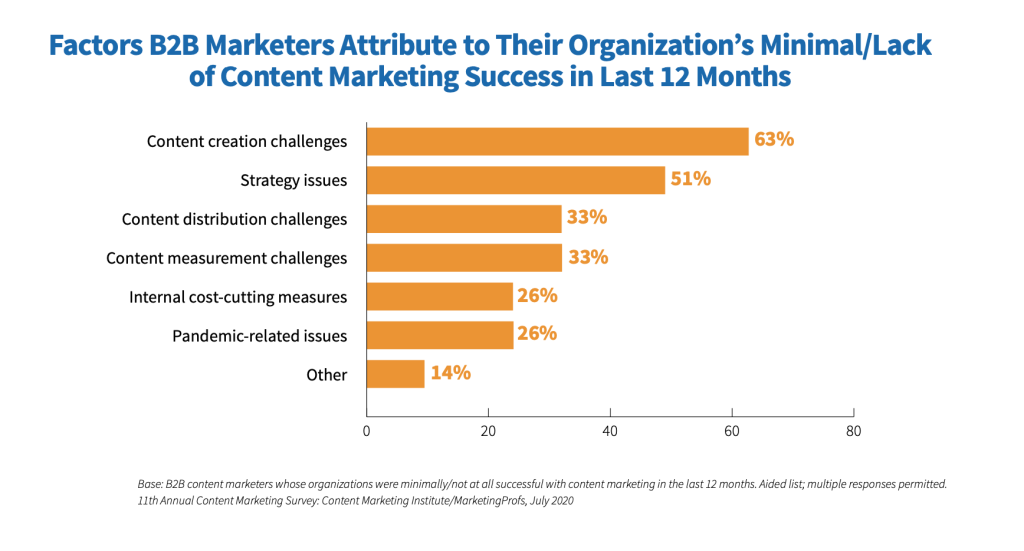Marketing is easy.
What’s not easy? Producing good marketing.
Specifically, good content marketing.
As twenty-first century marketers, we celebrate the speed and agility of finding the insights we need. But at the same time, brands are coming to understand that most eBooks and infographics only add to the landfills of B2B information, requiring decision-makers to wade through a lot of un-targeted and unnecessary chatter. Often, creating roadblocks in the buyer journey.
The rise of content marketing comes as a result of the advent of digital platforms – websites, blogs, social – that ‘hot-in-demand’ content to keep vendors full and fresh. Previously, content often came through slower media formats, typically printed. Therefore, saw much less demand and fewer, more skilled creators than today’s mass output by anyone with a keyboard.
Where are we falling short?
Research from the Content Marketing Institute suggests that B2B marketers are successfully using content to hit their top-of-the-funnel goals, like brand awareness and education.
Which is great.

But if picture is worth a thousand words, this one shows how badly B2B marketers struggle to produce content that provides value. And with 63% struggling to create content that satisfies their buyer’s unmet needs, it’s no wonder so much fails to convert.

So, what’s next?
With almost half of the surveyed brands now placing their content marketing efforts as a key business priority, there is a risk that you’ll get left behind. To help make sure you’re heading in the right direction, here are four tell-tale traps to avoid and our advice on creating better work that delivers.
Trap 1: Content Stuffing
Perhaps we’re afraid the content marketing bubble might burst, or hopeful our upcoming how-to guide will be the next ‘viral-thing’ on all our prospect’s lips. Whatever it might be, the danger comes when we try to cram excess information into everything.
In doing so, it often dilutes the core message and results in a very mediocre outcome. Plus, if you give it all upfront, there will be less to dazzle your prospects with once pitch stage arrives.
With our busy lifestyles, wouldn’t it be better to combine your best insights into one succinct piece, or a few covering several related topics?
Although it might require additional resource, according to HubSpot’s best practice advice, the latter might be more preferable.
Our approach.
At Energi, we’re taking a ‘library approach’ to our content strategy. One person will map out a series of topics under an over-arching theme each quarter, and assign each to team members according to their strengths. The research, writing and refining is down to the individual to action. Then, that same person reviews all the work and deals with the deployment accordingly.
We’ve found this particularly effective in B2B, where client work often takes priority, giving everyone a chance to bring their expertise to the table while avoiding cramming too much into one piece or onto one person’s plate.
The result? A comprehensive series of insightful articles that complements multiple areas of the reader’s business. Grab a cuppa and have a nosey.
Our advice: Communicate your desired messages throughout your team, plan ahead so they have time to deliver a quality piece, and assign one person to the final editing duties before going live. That way, creative control is maintained more consistently.
Trap 2: Slipping into The Quantity Pothole
These days, a lot of brands are engaged in a content arms race, trying to achieve competitive advantage by producing anything possible, that any possible buyer, could possibly need…. at any possible time.
Alongside this, the age-old ‘quantity versus quality’ debate rages on with many businesses concluding that quantity is more important.
However, battling for numerical superiority means nothing if your content isn’t engaging. This also often weakens audience urgency to engage with brands for problem-solving. In the same vein, too little content can carry the same result. The content surge over the past decade has degraded the traditional currency of ideas, and as a result; commoditised the generic concept itself.
Our advice: In an ideal world, hitting both would be a breeze – but deploying sustainably large volumes of quality content might not be feasible for your business yet. So, it makes sense to focus on leveraging your best ideas, track and refine your top-performing work and then look for new ways and resource that allow you to scale.
To make sure you’re heading in the right direction, here are some insights on resonating with your target audience through appealing to their core drivers.
Trap 3: Content Committees
“There are as many opinions as there are experts.”- Franklin D. Roosevelt
In the B2B world, it’s increasingly difficult to market to marketers as everyone has a view on the best way forward. Too many cooks in the content kitchen can be marketing suicide to even the greatest of strategies.
Don’t get us wrong, having intel from different areas of the business can help create some highly effective work – but when too much time is spent deliberating everybody’s opinions and ideas, it can sabotage a committee’s original purpose.
Just like the first trap, you don’t have to fit everything into everything, so use your meeting time as a consultative opportunity to ensure all ideas align and support the wider company strategy for that quarter (or whatever timescale you choose to use). But from there, a smaller team or individual should call the shots.
Our advice: When addressing your team, have the conviction to stand by your decisions, explain the rationale behind them and be open to critique. Above all, take all stakeholders on the journey with you, ensure they’re on board with your strategy, and consistently improve it based on the data at your disposal.
Trap 4: Not Defining Who You Are
Every human has an in-built nonsense detector.
Some are more astute than others, but the fact is, even in B2B, buyers are becoming desensitised towards marketing tactics, and if something looks and smells like marketing – they’ll likely run for the hills.
By sticking to your brand proposition, your target audience is more likely to trust your expertise (and understand that while you might not be a fountain of all knowledge, you’re the fountain of knowledge on what they need).
If you haven’t defined your niche yet, we suggest making it a priority to it’ll help you avoid spreading your messaging too broad and losing interest. Or worse, making accidental claims about being something you’re not (bad reviews travel fast).
Our advice:
1. Define and agree on your company’s sweet spot
2. Own a tightly defined subject area
3. Explore the edges (aka, don’t veer too far)
In essence, leave out the unnecessary, and create honest, insightful and engaging content.
Not too much, not too little and don’t settle for mediocre.
Empathise, don’t bluff and don’t be too nice. Easy, right?
Perhaps not, but if in doubt and you need a hand, we would love to help you get there and make sure your content never ends up in the trash.





